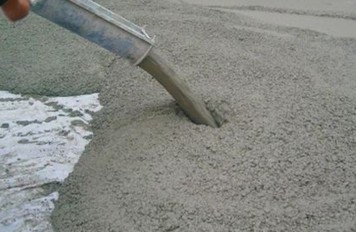Using a by-product of steel production to enhance the mechanical properties of concrete

According to a new study, the utilization of a by-product of steel making may be used in concrete mixtures providing increased strength.
The by-product is known as "steel slag" and derives from the cooling process of molten liquid steel. Practically, it is produced when molten steel is separated from impurities. The product usually contains a mixture of silicon dioxide and metal oxides but it may also have elemental metals or metal sulfides.
Steel slag has been widely used for the production of concrete and it has proven to be effective, improving the mechanical properties of the mixture.
The product has also been utilized in wastewater treatment as it can absorb pollutants (e.g. magnesium, aluminium, phosphate, iron and others). However, its potency is lost over time and it becomes less effective.
The new study, recently published in Resources, Conservation & Recycling Journal, investigated the addition of steel slag, previously used to treat wastewater, in concrete mixtures. It is the first research attempt to examine the applicability of "sewage-enhanced" steel slag in the concrete industry.
The results of the study showed that specimens (concrete cylinders 100× 200 mm) created using treated steel slag presented an average uniaxial compressive strength increase of 16.8% and 8.2% at 28 days in comparison to samples in which raw slag or conventional aggregates were utilized, respectively.
The endeavor not only benefits concrete as a construction material but it also aims at creating an eco-friendly solution regarding steel production waste. “The global steel making industry produces over 130 million tons of steel slag every year. A lot of this by-product already goes into concrete, but we’re missing the opportunity to wring out the full benefits of this material. Making stronger concrete could be as simple as enhancing the steel slag by first using it to treat our wastewater. While there are technical challenges to overcome, we hope this research moves us one step closer to the ultimate goal of an integrated, no-waste approach to all our raw materials and by-products,” Dr. Biplob Pramanik, co-author of the study and Lecturer in Water Engineering at RMIT University, stated.
Authors suggest that, during the wastewater treatment, the chemical properties of steel slag alter, transforming the product that becomes more effective when used in concrete mixtures. “The things that we want to remove from water are actually beneficial when it comes to concrete, so it’s a perfect match,” Pramanik added.
The future steps of the research project include assessing the long-term response of the new concrete mixture and evaluating its performance at a larger-scale.
Currently, steel slag is not widely used in wastewater treatment, however, if construction, steel production and wastewater industries collaborate, there is a great potential of manipulating the benefits of this by-product.
Source: RMIT University
Want to read more like this story?

The future of steel production and steel structure construction
Nov, 27, 2022 | NewsThis article will explore four technologies that are helping shape the future of steel construction...
Concrete Structures
Jan, 01, 2019 | EducationConcrete structures are constructions that utilize concrete as the primary building material. Conc...

Zero-cement concrete will reduce the environmental impact in construction industry
Aug, 08, 2024 | NewsDue to the climate crisis and the high CO2 emissions of concrete, engineers and scientists are seek...
Steel Structures
Jan, 01, 2019 | EducationThe term “steel structures” refers to constructions that rely primarily on steel as the main build...

Bentley Webinar | Advanced Design & Analysis of Industrial & Commercial Structures
Jul, 20, 2023 | EventElevate Your Concrete and Steel Design: Embrace the Power of RAM Connection and STAAD Advanced Conc...

INSTANT steel
Aug, 27, 2014 | Software
Concrete that traps CO2 emissions for good
Jul, 16, 2018 | NewsA new method to produce concrete that traps harmful CO2 emissions and increases the compression stre...

Potential problems and solutions in steel structures
Nov, 09, 2023 | NewsEvery construction material, including steel, is sensitive to various issues. Although steel remain...

Improving concrete's fire resistance with tire fibers
Feb, 28, 2019 | NewsIn a new study, researchers have developed a method to improve concrete's performance when subjected...
Trending

Spectacular interchanges around the world

New Release - STAAD.Pro 2024 - 2

ADINA 2025 for Structural WorkSuite

ADINA 2025 New Release!

Concrete Buildings as Rechargeable Batteries

Powerful earthquake shakes central Philippines, dozens killed


